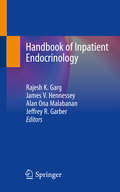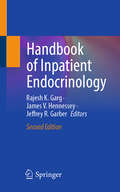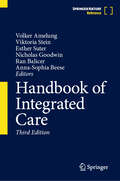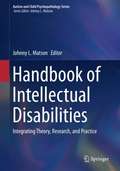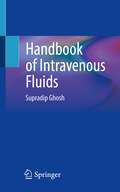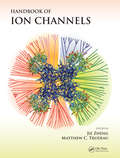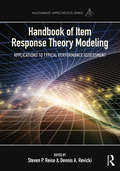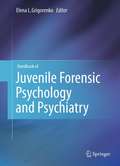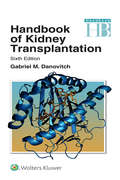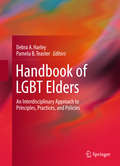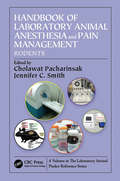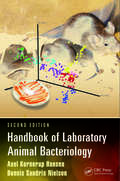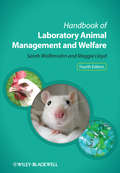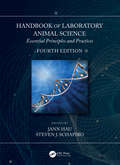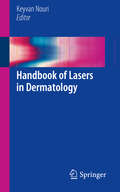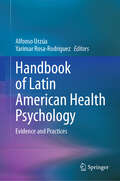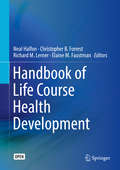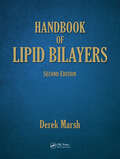- Table View
- List View
Handbook of Inpatient Endocrinology
by Rajesh K. Garg James V. Hennessey Alan Ona Malabanan Jeffrey R. GarberA user-friendly, pocket-sized reference for all physicians faced with endocrine care and challenges in hospitalized patients, this handbook covers the most common issues leading to an inpatient endocrine consult, providing differential diagnoses, a reasonable and practical approach to investigating and managing the condition, and advice for follow-up. Conditions discussed include thyrotoxicosis and thyroid storm, calcium disorders, osteoporosis, Cushing's syndrome, pheochromocytoma and paraganglioma, primary hyperaldosteronism, hypoglycemia in diabetic and non-diabetic patients, and endocrine issues during pregnancy, among others. Suggestions for further reading are included, providing more context for well-established clinical approaches. Written by experts with years of experience providing endocrinology consultations in a hospital setting, Handbook of Inpatient Endocrinology is a valuable, high-yield resource for endocrine residents and fellows, but it will be equally useful for any busy hospitalist or primary care physician when endocrinology consults are not available.
Handbook of Inpatient Endocrinology
by Rajesh K. Garg James V. Hennessey Jeffrey R. GarberThe handbook of Inpatient Endocrinology 2nd Edition is written by experts with vast experience in hospital-based care. It is an easy-to-navigate, concise pocket-sized reference text. It covers updated guidance on new therapeutic agents, revised care pathways, differential diagnosis, investigation, management, follow-up, and transitioning care to the ambulatory setting. Conditions include thyroid dysfunction, calcium disorders, adrenal disorders, osteoporosis, hypoglycemia in diabetic and non-diabetic patients, and endocrine disorders in pregnancy. Suggestions for further reading appear with each chapter. Although it was originally conceived as a resource for medical residents and endocrine fellows it is a valuable resource for all those who provide complex inpatient endocrine care.
Handbook of Insulin Therapies
by Winston Crasto Janet Jarvis Melanie J. DaviesA clinically-focused handbook that provides an overview of the different types of insulin, delivery methods, emerging treatments, and cutting-age devices. The aim of the handbook is to discuss insulin treatment strategies that can improve glucose control, enhance patient adherence, and minimize adverse effects and disease-related complications. Concise scope and size is ideal for busy healthcare professionals that regularly encounter patients with diabetes and require an up-to-date snapshot of advances in diabetes care.
Handbook of Integrated Care
by Volker Amelung Viktoria Stein Nicholas Goodwin Ran Balicer Esther Suter Anna-Sophia BeeseThis handbook shares profound insights into the main principles and concepts of integrated care. It offers a multi-disciplinary perspective with a focus on patient orientation, efficiency, and quality by applying widely recognized management approaches to the field of healthcare. The handbook also highlights international best practices and shows how integrated care can work in various health systems. In the majority of health systems around the world, the delivery of healthcare and social care is characterised by fragmentation and complexity. Consequently, much of the recent international discussion in the fields of health policy and health management has focused on the topic of integrated care. &“Integrated&” acknowledges the complexity of patients&’ needs and aims to meet them by taking into account both health and social care aspects. Changing and improving processes in a coordinated way is at the heart of this approach. The third edition offers new chapters on people-centredness, complexity theories and evaluation methods, additional management tools and a wealth of experiences from different countries and localities. It is essential reading both for health policymakers seeking inspiration for legislation and for practitioners involved in the management of public health services who want to learn from good practice.
Handbook of Integrative Dermatology
by Peter A. Lio Toral Patel Neill T. Peters Sarah KasprowiczThis user-friendly reference tool presents clinical scenarios and discusses some practical complementary and alternative therapies available in dermatology. It focuses on peer-reviewed data that are suitable for use in a conventional dermatology practice and helps dermatologists guide their patients when faced with questions regarding integrative dermatology using an evidence-based, reader-friendly, and case-focused approach. Within the field of dermatology, there is a marked void in the understanding of complementary and alternative approaches, though dermatologists frequently use off-label therapies to manage chronic conditions. They do so, however, with a range of success and potentially considerable side effect profiles. Handbook of Integrative Dermatology is a must-have tool for any practicing dermatologist.
Handbook of Intellectual Disabilities: Integrating Theory, Research, and Practice (Autism and Child Psychopathology Series #Volume 34)
by Johnny L. MatsonThis handbook offers a comprehensive review of intellectual disabilities (ID). It examines historical perspectives and foundational principles in the field. The handbook addresses philosophy of care for individuals with ID, as well as parent and professional issues and organizations, staffing, and working on multidisciplinary teams. Chapters explore issues of client protection, risk factors of ID, basic research issues, and legal concerns. In addition, chapters include information on evidence-based assessments and innovative treatments to address a variety of behaviors associated with ID. The handbook provides an in-depth analysis of comorbid physical disorders, such as cerebral palsy, epilepsy and seizures, and developmental coordination disorders (DCD), in relation to ID.Topics featured in this handbook include:Informed consent and the enablement of persons with ID. The responsible use of restraint and seclusion as a protective measure. Vocational training and job preparation programs that assist individuals with ID. Psychological and educational approaches to the treatment of aggression and tantrums. Emerging technologies that support learning for students with ID. Key sexuality and relationship issues that are faced by individuals with ID.Effective approaches to weight management for individuals with intellectual and developmental disabilities. The Handbook of Intellectual Disabilities is an essential reference for researchers, graduate students, clinicians and related therapists and professionals in clinical child and school psychology, pediatrics, social work, developmental psychology, behavioral therapy/rehabilitation, child and adolescent psychiatry, and special education.
Handbook of Interdisciplinary Treatments for Autism Spectrum Disorder (Autism and Child Psychopathology Series)
by Robert D. RieskeThis handbook examines the medical and therapeutic needs of individuals with autism spectrum disorder (ASD) and the effectiveness of treatments that are delivered through interdisciplinary teams. It analyzes the impact of interdisciplinary teams on assessment, diagnosis, treatment planning, and implementation and explores how evidence-based treatments can be developed and implemented. Chapters describe the wide-ranging effects of ASD and the challenges individuals and their family members face when seeking treatment. In addition, chapters provide an overview of the comorbidities and related disorders that often accompany ASD, including neurodevelopmental disorders, medical and behavioral problems, and psychopathology. The handbook also discusses the critical importance of caregivers in the treatment team as experts in their child’s strengths, problem areas, and functioning. Topics featured in this handbook include:Legal considerations in interdisciplinary treatments.Ethical considerations in the development and implementation of interdisciplinary teams.Evidence-based interdisciplinary treatment and evaluation considerations.The role of primary care physicians and subspecialty pediatricians within interdisciplinary teams. The impact of school psychologists related to assessment and intervention development. Vocational interventions that promote independence in individuals with ASD. The Handbook of Interdisciplinary Treatments for Autism Spectrum Disorder is a must-have resource for researchers, clinicians and professionals, and graduate students across such interrelated disciplines as clinical child, school, and developmental psychology, child and adolescent psychiatry, social work, rehabilitation medicine/therapy, pediatrics, and special education.
Handbook of International Health Care Systems
by Khi V. Thai Edward T. Wimberley Sharon M. McManus"Presents a comprehensive overview of the current state of health care and availability worldwide. Focuses on the appraoch to the provision of quality, cost-effective health care systems by ""established"" and developing member countries of the Organization for Economic Cooperation and Development (OECD). Compares health care financing across all O
Handbook of Intravenous Fluids
by Supradip GhoshThis easy to use pocket book covers all aspects of intravenous fluid therapy in critically ill patients from applied physiology to bedside clinical management succinctly. It includes updated and evidence-based content on intravenous fluid therapy. The book is divided into four sections; first section covering review of physiology, second section describing different resuscitation agents, third section discussing fluid therapy in various clinical conditions and final section providing a rational approach to prescribing intravenous fluid. Each chapter starts with a case scenario followed by an introduction focusing on the learning objectives and take home message and recommendation at the end. Each chapter includes a summary of important clinical trials in the field, especially useful for students. The book maintains uniform style throughout the chapters, written in simple language and includes charts, boxes, tables and figures.The book is useful for all clinicians dealing with acutely ill patients including (but not limited to) intensivists, emergency physicians, anaesthesiologists, internists, other physicians and surgeons as well as trainees.
Handbook of Ion Channels
by Jie Zheng Matthew C. TrudeauThe New Benchmark for Understanding the Latest Developments of Ion ChannelsIon channels control the electrical properties of neurons and cardiac cells, mediate the detection and response to sensory stimuli, and regulate the response to physical stimuli. They can often interact with the cellular environment due to their location at the surface of ce
Handbook of Iron Overload Disorders
by James C. Barton Corwin Q. Edwards Pradyumna D. Phatak Robert S. Britton Bruce R. BaconA practical, clinically-oriented handbook of iron overload disorders giving a compact guide to normal iron metabolism, iron-related pathobiology, and the diagnosis and management of heritable and acquired iron overload disorders. Many of these disorders were discovered and characterized only in the last decade, and are unmentioned or inadequately described in most texts. Written by clinicians for clinicians, this handbook summarizes information on diverse iron overload conditions, including their history, signs, symptoms, physical examination findings, genetics, genotype-phenotype correlations, pathophysiology, differential diagnosis and treatment. Most physicians, regardless of specialty, encounter patients with systemic or organ-specific iron overload conditions. This book contains essential information for practising adult and pediatric medical specialists in the fields of hematology, gastroenterology, hepatology, rheumatology, endocrinology, diabetology, neurology, oncology, dermatology and internal medicine. Pathologists, pharmacologists, geneticists, genetic counselors and epidemiologists will also find substantial, up-to-date sections in this handbook that are pertinent to their respective fields of interest.
Handbook of Item Response Theory Modeling: Applications to Typical Performance Assessment (Multivariate Applications Series)
by Steven P. Reise and Dennis A. RevickiItem response theory (IRT) has moved beyond the confines of educational measurement into assessment domains such as personality, psychopathology, and patient-reported outcomes. Classic and emerging IRT methods and applications that are revolutionizing psychological measurement, particularly for health assessments used to demonstrate treatment effectiveness, are reviewed in this new volume. World renowned contributors present the latest research and methodologies about these models along with their applications and related challenges. Examples using real data, some from NIH-PROMIS, show how to apply these models in actual research situations. Chapters review fundamental issues of IRT, modern estimation methods, testing assumptions, evaluating fit, item banking, scoring in multidimensional models, and advanced IRT methods. New multidimensional models are provided along with suggestions for deciding among the family of IRT models available. Each chapter provides an introduction, describes state-of-the art research methods, demonstrates an application, and provides a summary. The book addresses the most critical IRT conceptual and statistical issues confronting researchers and advanced students in psychology, education, and medicine today. Although the chapters highlight health outcomes data the issues addressed are relevant to any content domain. The book addresses: IRT models applied to non-educational data especially patient reported outcomes Differences between cognitive and non-cognitive constructs and the challenges these bring to modeling. The application of multidimensional IRT models designed to capture typical performance data. Cutting-edge methods for deriving a single latent dimension from multidimensional data A new model designed for the measurement of constructs that are defined on one end of a continuum such as substance abuse Scoring individuals under different multidimensional IRT models and item banking for patient-reported health outcomes How to evaluate measurement invariance, diagnose problems with response categories, and assess growth and change. Part 1 reviews fundamental topics such as assumption testing, parameter estimation, and the assessment of model and person fit. New, emerging, and classic IRT models including modeling multidimensional data and the use of new IRT models in typical performance measurement contexts are examined in Part 2. Part 3 reviews the major applications of IRT models such as scoring, item banking for patient-reported health outcomes, evaluating measurement invariance, linking scales to a common metric, and measuring growth and change. The book concludes with a look at future IRT applications in health outcomes measurement. The book summarizes the latest advances and critiques foundational topics such a multidimensionality, assessment of fit, handling non-normality, as well as applied topics such as differential item functioning and multidimensional linking. Intended for researchers, advanced students, and practitioners in psychology, education, and medicine interested in applying IRT methods, this book also serves as a text in advanced graduate courses on IRT or measurement. Familiarity with factor analysis, latent variables, IRT, and basic measurement theory is assumed.
Handbook of Juvenile Forensic Psychology and Psychiatry
by Elena L. GrigorenkoJuvenile justice centers have a long tradition as an unfortunate stop for young offenders who need mental health care. Reports estimate that as many as 70% of the youth in detention centers meet criteria for mental health disorders. As juvenile justice systems once again turn their focus from confinement to rehabilitation, mental health providers have major opportunities to inform and improve both practice and policy. The Handbook of Juvenile Forensic Psychology and Psychiatry explores these opportunities by emphasizing a developmental perspective, multifaceted assessment, and evidence-based practice in working with juvenile offenders. This comprehensive volume provides insights at virtually every intersection of mental health practice and juvenile justice, covering areas as wide-ranging as special populations, sentencing issues, educational and pharmacological interventions, family involvement, ethical issues, staff training concerns, and emerging challenges. Together, its chapters contain guidelines not only for changing the culture of detention but also preventing detention facilities from being the venue of choice in placing troubled youth. Key issues addressed in the Handbook include: Developmental risks for delinquency.Race and sex disparities in juvenile justice processing.Establishing standards of practice in juvenile forensic mental health assessment.Serving dually diagnosed youth in the juvenile justice system.PTSD among court-involved youth.Female juvenile offenders.Juvenile sex offenders.The Handbook of Juvenile Forensic Psychology and Psychiatry is an essential reference for researchers, professors, allied clinicians and professionals, and policy makers across multiple fields, including child and school psychology, child and adolescent psychiatry, developmental psychology, criminology, juvenile justice, forensic psychology, neuropsychology, social work, and education.
Handbook of Kidney Transplantation
by Gabriel M. DanovitchThis popular handbook is a practical guide for physicians, surgeons, nurses, and other professionals who manage kidney transplant patients. It is concise, readable, and well-illustrated. Chapters outline the major concerns surrounding renal transplantation and the most successful approaches to problems arising in short-term and long-term patient care. Chapter topics include immunobiology and immunosuppression, as well as chapters on surgery, histocompatibility, and the first three months post-transplant surgery.
Handbook of LGBT Elders
by Debra A. Harley Pamela B. TeasterThis groundbreaking resource presents a wealth of findings and perspectives previously unseen in the LGBT literature. Its focus on psychological, sociopolitical and care delivery issues affecting LGBT elders reveals both the nuanced interplay between diverse sources of identity and multiple sources of stigma and discrimination. Specific chapters highlight challenges and resiliencies impacting subpopulations (e. g. , racial groups, veterans, immigrants), examine employment and advocacy issues, discuss later-life concerns in context and offer guidelines for relevant, ethical practice. Contributors represent a wide range of fields from psychiatry and gerontology to public health and public policy, reflecting the scope and needs of this diverse and complex population. Among the topics in the Handbook: Family relationships of older LGBT adults. The intersection of identities: race, age, sexuality and care network. Bisexuality: an invisible community among LGBT elders. Implications of the Supreme Court ruling on same-sex marriage. No money, no work and you're old. Disabilities among LGBT elders: responses of medicine, public health, rehabilitation and social work. Handbook of LGBT Elders is an essential reference for mental health professionals, psychologists and social workers who work with the LGBT community and the elderly, as well as researchers interested in the LGBT community and aging.
Handbook of Laboratory Animal Anesthesia and Pain Management: Rodents (Laboratory Animal Pocket Reference)
by Cholawat Pacharinsak Jennifer C. SmithKey features: Presents practical information in easily accessible ‘bullet point’ format Covers anesthetic machine and related equipment, anesthetic management and monitoring, anesthesia and analgesia pharmacology, euthanasia, and record keeping Written by well-recognized experts in the laboratory animal community Provides extensive references to direct the reader to sources for further study of alternative techniques and their procedures Concludes with a thorough chapter on Regulatory Management of Rodent Anesthesia which has global application Rodents are the most commonly used species in biomedical research. Individuals conducting rodent research are often responsible to ensure that all areas of anesthesia and analgesia are performed humanely. Anesthetic agent selection, anesthetic monitoring, and postoperative pain assessment and management are essential to the institutional animal care and use program and contribute significantly to the 3Rs by reducing pain and/or distress and refining various procedures. The Handbook of Laboratory Animal Anesthesia and Pain Management: Rodents is the first book to capture multiple advances in this important area that greatly impacts various experimental methodologies. Richly illustrated in full color, the book serves as a quick reference source for investigators, veterinarians, technicians, and other animal caretakers charged with the care and use of rodents in a research setting. The unique format of this book also makes it extremely valuable to IACUC members, institutional officials, and occupational health and safety professionals.
Handbook of Laboratory Animal Bacteriology
by Axel Kornerup Hansen Dennis Sandris NielsenThe Handbook of Laboratory Animal Bacteriology, Second Edition provides comprehensive information on all bacterial phylae found in laboratory rodents and rabbits to assist managers, veterinary pathologists and laboratory animal veterinarians in the management of these organisms. The book starts by examining the general aspects of bacteriology and h
Handbook of Laboratory Animal Management and Welfare
by Sarah Wolfensohn Maggie LloydThis bestseller has been an essential book for all those working with laboratory animals since it was first published in 1994. This fourth edition retains all the classic features that have made it a must-have reference including emphasis on best practice in order to improve animal welfare. The contents have been thoroughly updated and reorganised to make sure it is a really practical book for day-to-day use in the laboratory. The first section of the book covers principles applicable to all species, for example husbandry, handling and the education and training required by scientists and technical staff working with animals in the laboratory. Later chapters focus on specific species or groups of species.New to this edition:* Reflects changes in European legislation and their impact on national legislation* Covers recommendations for the education and training of those carrying out animal experiments across Europe * New chapters on ethical considerations and balancing animal welfare with science* New information on environmental enrichment for laboratory animals* Covers advancements in anaesthesia and analgesia and techniques* Spiral bound for ease-of-use as a bench-top referenceThis book is ideal for all personnel carrying out scientific procedures using animals, particularly during training and also for the new researcher. It will also be essential reading for study directors designing research programmes, animal technicians and veterinarians working with laboratory animal species.
Handbook of Laboratory Animal Science: Essential Principles and Practices
by Jann HauBuilding upon the success of previous editions of the bestselling Handbook of Laboratory Animal Science, first published in 1994, this latest revision combines all three volumes in one definitive guide. It covers the essential principles and practices of Laboratory Animal Science as well as selected animal models in scientific disciplines where much progress has been made in recent years. Each individual chapter focuses on an important subdiscipline of laboratory animal science, and the chapters can be read and used as stand-alone texts, with only limited necessity to consult other chapters for information. With new contributors at the forefront of their fields, the book reflects the scientific and technological advances of the past decade. It also responds to advances in our understanding of animal behavior, emphasizing the importance of implementing the three Rs: replacing live animals with alternative methods, reducing the number of animals used, and refining techniques to minimize animal discomfort. This fourth edition will be useful all over the world as a textbook for laboratory animal science courses for postgraduate and undergraduate students and as a handbook for scientists who work with animals in their research, for university veterinarians, and for other specialists in laboratory animal science.
Handbook of Lasers in Dermatology
by Keyvan NouriThis book discusses lasers and light technologies in dermatology. The innovation is due to the book format: a handbook. It is the first handbook of lasers in dermatology, facilitating access to information to all individuals interested in lasers in this specific medical field . The most recent lasers devices and its applications will be discussed. Illustrations and tables will make the book didactic and comprehensive. Lasers in dermatology are a constantly evolving field. Over the past few decades, novel devices have been developed and new indications for their use have emerged. A broad understanding of the relationship between science and laser principles is the foundation of a solid dermatologic practice. The Lasers in Dermatology Handbook is a tool to understand the use of lasers in clinical practice. Important topics such as vascular lesions, warts, acne, scars, and pigmented lesions are presented and discussed in all aspects. The wide spectrum of laser and light technologies available for skin resurfacing and rejuvenation will be covered as well. Written by internationally renowned authors, this handbook serves as a cornerstone for laser applications and provides updated information for all physicians, particularly dermatologists, interested in implementing lasers in their practice.
Handbook of Latin American Health Psychology: Evidence and Practices
by Alfonso Urzúa Yarimar Rosa-RodríguezThis handbook presents a comprehensive overview of a tradition of psychological research and practice little known in the English-speaking world: the Latin American school of health psychology. Even though health psychology as a field of research and practice was born in Latin America with the creation of the National Group of Health Psychology within the Cuban Ministry of Public Health in 1969, this genesis is seldom acknowledged in the international literature. And even less is known on an international level about the original contributions that Latin American health psychologists have made and still make to the development of the discipline. This volume aims to fill this gap by presenting to the international community a comprehensive account of the particular trajectory of health psychology in Latin America and the original contributions made by a field of research and practice that has always tried to integrate a socio-culturally sensitive approach to develop studies and interventions in health promotion and disease prevention. This is done by bringing together chapters written by leading experts from the region that explain the specific social, political and cultural contexts in which health psychology developed in Latin America; present the original theoretical and methodological approaches developed by Latin American health psychologists; and provide an overview of current research done in the region about the contribution of psychology to the management of various health conditions. The Handbook of Latin American Health Psychology will be of interest to researchers, practitioners and students interested in the internationalization and cross-cultural generalizability of health psychology, as a tool for building a truly global and culturally sensitive discipline. Some chapters of this handbook were originally written in Spanish and translated into English with the help of artificial intelligence. A subsequent human revision was done primarily in terms of content.
Handbook of Life Course Health Development
by Richard M. Lerner Neal Halfon Christopher B. Forrest Elaine M. FaustmanThis book is open access under a CC BY 4. 0 license. This handbook synthesizes and analyzes the growing knowledge base on life course health development (LCHD) from the prenatal period through emerging adulthood, with implications for clinical practice and public health. It presents LCHD as an innovative field with a sound theoretical framework for understanding wellness and disease from a lifespan perspective, replacing previous medical, biopsychosocial, and early genomic models of health. Interdisciplinary chapters discuss major health concerns (diabetes, obesity), important less-studied conditions (hearing, kidney health), and large-scale issues (nutrition, adversity) from a lifespan viewpoint. In addition, chapters address methodological approaches and challenges by analyzing existing measures, studies, and surveys. The book concludes with the editors' research agenda that proposes priorities for future LCHD research and its application to health care practice and health policy. Topics featured in the Handbook include: The prenatal period and its effect on child obesity and metabolic outcomes. Pregnancy complications and their effect on women's cardiovascular health. A multi-level approach for obesity prevention in children. Application of the LCHD framework to autism spectrum disorder. Socioeconomic disadvantage and its influence on health development across the lifespan. The importance of nutrition to optimal health development across the lifespan. The Handbook of Life Course Health Development is a must-have resource for researchers, clinicians/professionals, and graduate students in developmental psychology/science; maternal and child health; social work; health economics; educational policy and politics; and medical law as well as many interrelated subdisciplines in psychology, medicine, public health, mental health, education, social welfare, economics, sociology, and law.
Handbook of Life Course Occupational Health (Handbook Series in Occupational Health Sciences)
by Morten Wahrendorf Tarani Chandola Alexis DescathaThis handbook provides a comprehensive overview of recent developments in research on the relationship between occupational trajectories over the life course and health. It uncovers the impact of far-reaching changes of work and employment, as evidenced by increased flexibility, discontinuity, and technological innovation, and offers insights into recent theoretical and methodological developments addressing this challenge. In its main parts, it presents the best evidence to readers about the following topics: early life influences on (un)healthy work, chronic exposure to occupational risks; nonstandard employment and poor health; work continuation with chronic disease; occupational determinants of healthy aging. In its final part, it discusses policy implications of current knowledge and points to the need of developing new solutions in research and practice, not least in times of climate crisis and the new pandemic.The important handbook has been prepared by a distinguished editorial team, with chapters written by prominent international experts. Despite its continuous reference to scientific knowledge it addresses its content to a broader, non-specialized readership.
Handbook of Lipid Bilayers
by Derek MarshNow in its second edition, the Handbook of Lipid Bilayers is a groundbreaking work that remains the field's definitive text and only comprehensive source for primary physicochemical data relating to phospholipid bilayers. Along with basic thermodynamic data, coverage includes both dynamic and structural properties of phospholipid bilayers. It is an
Handbook of Lipid Membranes: Molecular, Functional, and Materials Aspects
by Cyrus R. Safinya Joachim O. RädlerThis handbook provides a unique overview of lipid membrane fundamentals and applications. The fascinating world of lipids that harbor and govern so many biological functionalities are discussed within the context of membrane structures, interactions, and shape evolution. Beyond the fundamentals in lipid science, this handbook focuses on how scientists are building bioinspired biomimetic systems for applications in medicine, cosmetics, and nanotechnology. Key Features: Includes experimental and theoretical overviews on the role of lipids, with or without associated biomolecules, as structural components imparting distinct membrane shapes and intermembrane interactions Covers the mechanisms of lipid-membrane curvature, by peptide and protein binding, and the roles of signalling lipids and the cytoskeleton in plasma membrane shape evolution Covers advanced X-ray and force measurement techniques Discusses applications in biomedicine, cosmetics, and nanotechnology, including lipid vectors in nucleic acid, drug delivery in dermal applications, and lipid-based sensors and artificial biointerfaces Covers artificial membranes from block copolymers, synthetic copolypeptides, and recombinant proteins Includes an exciting section that explores the role of lipids in the origin of life in hydrothermal conditions This book is a highly informative companion for professionals in biophysics, biochemistry, physical chemistry, and material and pharmaceutical sciences and bioengineering.
